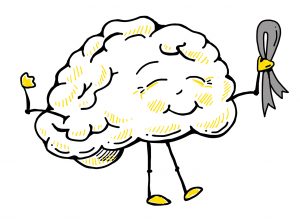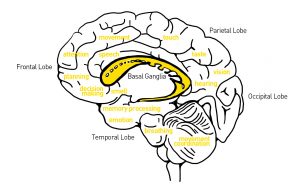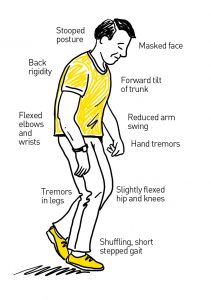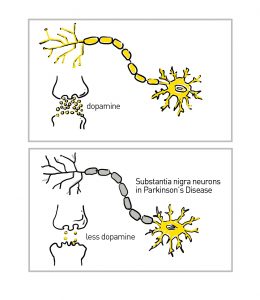An Everyday DNA blog article
Written by: Sarah Sharman, PhD
Illustrated by: Cathleen Shaw
 The brain is one of the most complex and fascinating organs in the human body. Weighing in at roughly 3 pounds, the small organ has big responsibilities. It’s like the conductor of a giant orchestra, coordinating and regulating everything that happens in our body. It controls our thoughts, feelings, and actions and is essential for our survival. A healthy brain is critical for maintaining overall well-being and high quality of life.
The brain is one of the most complex and fascinating organs in the human body. Weighing in at roughly 3 pounds, the small organ has big responsibilities. It’s like the conductor of a giant orchestra, coordinating and regulating everything that happens in our body. It controls our thoughts, feelings, and actions and is essential for our survival. A healthy brain is critical for maintaining overall well-being and high quality of life.
However, things go wrong in the brain sometimes, disrupting its normal functioning and causing a range of symptoms and impairments. Neurological conditions have a profound impact on an individual’s quality of life. The devastating symptoms cause physical and emotional distress. Understanding the underlying causes of these disorders is essential for developing effective treatments and improving the lives of those affected.
Every year in April, the spotlight shines on one such neurological condition, Parkinson’s disease. Organizations, patients, and their families raise awareness about the disease and secure funds to push Parkinson’s disease research forward. In the spirit of Parkinson’s Disease Awareness Month, let’s learn how the brain malfunctions to cause this devastating disease and what researchers are doing to better understand and treat the condition.
But first, what is a healthy brain?
Before we dive into the nuances of Parkinson’s disease and the quest for a cure, let’s take a small pit stop to learn more about the healthy brain. At first glance, the brain may not seem all that impressive. It’s a wrinkly, pinkish-grey organ that sits within our skulls. Unless something goes wrong with it, we don’t really think all that much about the organ controlling our every action. But it is actually a highly complex powerhouse organ that scientists don’t even fully understand.
 Just as an orchestra has different sections that work together to create beautiful music, the brain has many different parts that work together to create thoughts, emotion, and movements. The brain has four main lobes, each with its own role to play. The frontal lobe, located at the front of the brain, is responsible for decision-making, problem-solving, and personality. The parietal lobe, located towards the back of the brain, processes sensory information like touch, taste, and temperature and helps with spatial awareness and navigation. The temporal lobe, located on the side of the brain, processes sound and language and is also involved in memory and emotion. Finally, the occipital lobe, located at the back of the brain, processes visual information and allows us to see the world around us.
Just as an orchestra has different sections that work together to create beautiful music, the brain has many different parts that work together to create thoughts, emotion, and movements. The brain has four main lobes, each with its own role to play. The frontal lobe, located at the front of the brain, is responsible for decision-making, problem-solving, and personality. The parietal lobe, located towards the back of the brain, processes sensory information like touch, taste, and temperature and helps with spatial awareness and navigation. The temporal lobe, located on the side of the brain, processes sound and language and is also involved in memory and emotion. Finally, the occipital lobe, located at the back of the brain, processes visual information and allows us to see the world around us.
Billions of specialized cells called neurons transmit information throughout the brain and nervous system using electrical and chemical signals. When the cell body of a neuron is stimulated, an electrical impulse is generated and travels down the axon, away from the cell body. As the electrical signal reaches the end of the axon, chemicals called neurotransmitters are released into the gap between the neuron and the target cell. These neurotransmitters bind to receptors on the target cell (often another neuron), either exciting or inhibiting its activity.
Different neurotransmitters have different effects on the target cell. For example, serotonin is involved in mood regulation and sleep, acetylcholine plays a role in learning and memory, and GABA is an inhibitory neurotransmitter that helps calm the brain. Neurotransmitters allow neurons to communicate with each other and enable complex behaviors and thoughts. Imbalances in neurotransmitters have been linked to various mental health conditions, including depression, anxiety, and schizophrenia.
What is Parkinson’s disease?
 Parkinson’s disease is a progressive neurological disorder that predominantly affects movement. According to the Parkinson’s Foundation, approximately one million people in the United States and over 10 million people worldwide are currently living with Parkinson’s disease. The disease is more common in older adults, with the majority of cases diagnosed in people over the age of 60. However, it can also affect younger people, with an estimated 4% of cases diagnosed before the age of 50.
Parkinson’s disease is a progressive neurological disorder that predominantly affects movement. According to the Parkinson’s Foundation, approximately one million people in the United States and over 10 million people worldwide are currently living with Parkinson’s disease. The disease is more common in older adults, with the majority of cases diagnosed in people over the age of 60. However, it can also affect younger people, with an estimated 4% of cases diagnosed before the age of 50.
One of the most common symptoms of Parkinson’s disease is tremors – involuntary shaking that typically begins in the hands or arms. Other symptoms can include stiffness and rigidity in the limbs, slow movements, and difficulty with balance and coordination. As the disease progresses, it can also cause changes in speech and handwriting, as well as cognitive and emotional changes. Every person with Parkinson’s disease has a unique disease journey with a different mix and intensity of symptoms. There is no standard trajectory or path for disease progression.
For many diseases, a blood test or imaging can help doctors provide an accurate diagnosis. Unfortunately, for Parkinson’s disease, it is not that simple because there is no specific test that can definitively confirm the presence of the condition. Instead, diagnosis is based on a combination of clinical history, physical examination, and response to medications. During the physical exam, doctors look for two of three hallmark movement symptoms: resting tremor, stiffness, and slow movement. They may also test balance, coordination, and reflexes.
What causes the disease?
The cause of Parkinson’s disease has not been fully elucidated. Scientists know that symptoms of the disease are caused by a loss of dopamine-producing cells in a region of the brain called the substantia nigra. Dopamine is a neurotransmitter that coordinates movement as well as feelings of motivation and reward. The exact cause of cell death is not fully understood. It is believed to be a combination of genetic and environmental factors.

Mutations in certain genes, such as SNCA and LRRK2, were identified as risk factors for developing the disease. However, they are relatively rare and believed to account for only a small percentage of Parkinson’s disease cases. Environmental factors, such as exposure to certain toxins and chemicals, have also been linked to an increased risk of Parkinson’s disease. Studies show that exposure to some pesticides and herbicides, as well as other environmental toxins, may increase the risk of developing the disease.
There is also evidence to suggest that inflammation and oxidative stress in the brain may contribute to the development of Parkinson’s disease. These processes can damage cells and lead to the degeneration of dopamine-producing neurons. Overall, the causes of Parkinson’s disease are complex and not fully understood, but a combination of genetic and environmental factors is thought to contribute to the development of the disease.
Advances in Parkinson’s disease research
Despite ongoing research efforts, there is currently no cure for Parkinson’s disease. It can be a challenging condition to live with, but with the right treatment and support, many people are able to lead fulfilling and active lives for many years after diagnosis. Significant advances in research have led to new treatments and a better understanding of the disease.
One promising area of research is the development of new drugs that target the underlying mechanisms of Parkinson’s disease. For example, researchers are exploring the use of drugs that increase the levels of dopamine in the brain. The most common, currently available medications are levodopa and dopamine agonists, which help alleviate symptoms such as tremors, stiffness, and slowness of movement. Other drugs in the pipeline include those that target inflammation and oxidative stress that contribute to the degeneration of dopamine-producing neurons.
Another important area of research is the development of biomarkers that can help diagnose early-stage disease, track disease progression, and monitor therapeutic effectiveness in Parkinson’s disease. Biomarkers are measurable indicators of disease that can be detected through blood tests, brain imaging, and other methods. There are currently few minimally invasive biomarkers for Parkinson’s disease. At HudsonAlpha Institute for Biotechnology, Rick Myers, PhD, and his lab aim to develop blood-based predictive diagnostic biomarkers for neurodegenerative disorders, including Parkinson’s disease. The lab previously discovered cell-free nucleic acid biomarkers of colorectal adenoma, early lesions in the colon that could eventually develop into cancer.
Led by senior scientist Benjamin Henderson, PhD, the team is utilizing cutting-edge technology to identify biomarkers that could potentially aid in the early diagnosis of Parkinson’s disease. By collaborating with local clinics, the researchers plan to compare blood plasma samples from control groups to those diagnosed with Parkinson’s disease, with the aim of discovering unique small RNA molecules that are indicative of the disease. If these biomarkers are validated, they could be integrated into clinical care as a screening tool for individuals with a family history of neurodegenerative disease or undiagnosed neurological symptoms.
Myers’s lab is also focused on identifying genetic contributors to neurological disorders like Parkinson’s disease. Using single-cell technology, the team can study diseases on a cell-by-cell basis, looking at individual cell types one at a time. This means they could focus on dopamine-producing neurons to determine what goes wrong in Parkinson’s disease. By looking at individual cells, scientists gain new, more precise information on the genetic differences between the brain of someone with a disease compared to someone without the disease. Information gleaned in other neurological disorders, such as Alzheimer’s disease and dementia, can also help Myers and his lab learn new information about Parkinson’s disease with the ultimate goal of understanding the disease enough to identify new treatments and, eventually, a cure for this debilitating disease.
To learn more about HudsonAlpha’s neurodegenerative disease research program, listen to this episode of Tiny Expeditions.


